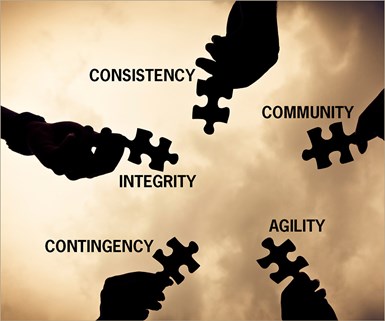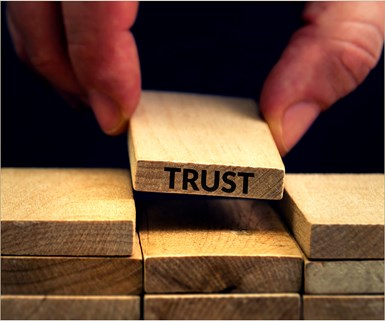Post-COVID Considerations for B2B Marketers
While we begin to return to “normal” from COVID-19, there are lessons for B2B marketers to learn and actions to take to recover and grow business as a result of this experience. Change is in order in how we look at B2B marketing, and our customers, in the near term “post-COVIDian” future. Call it a commonsense approach, rooted in proven best practices, our new-found “pull together” mentality and need to adapt to change. Not a blueprint, just parts and pieces to frame thinking. Sum it up in 5 words: Consistency; Community; Integrity; Agility; Contingency.
#customerfocus
The crisis touched all, damaged some, and can teach important lessons

By Mark Semmelmayer, CBC
Chief Idea Officer
Pen & Inc. Marketing Communications
Near-instantaneous communication be damned, this was written in April. When you read it, sometime in May, the nation’s COVID-19 status will have changed markedly. For instance, I live in Georgia. Barber shops, hair salons and bowling alleys open later this week. Restaurants and theatres next. We might be the first, but other states will soon follow.
Will we be out of the woods as you read? Sorry, can’t say . . . my crystal ball cracked weeks ago. Still in the shop (closed as “nonessential”). But it doesn’t take Nostradamus to predict the U.S., socially and economically, will be much different in 4 weeks.
While we begin to return to “normal,” I don’t think we’ll ever be the “same.” As B2B marketers, are there lessons to learn and actions to take, to recover and grow business as a result of this experience?
In a word, yes.
Don’t confuse me with a PhD social scientist, economist or marketing guru. Just a poor old B2B marketing guy looking at change. Thinking change may be in order in how we look at B2B marketing, and our customers, in the near term “post-COVIDian” future. Probably longer.
No research references here. Not that I didn’t research the topic. Thinking abounds, but data points are few. So, I’ll add my thinking. Call it a commonsense approach, rooted in proven best practices, our new-found “pull together” mentality and need to adapt to change. Ideas to consider. Not a blueprint, just parts and pieces to frame thinking.
Sum it up in 5 words: Consistency; Community; Integrity; Agility; Contingency.

Consistency
In the face of crisis, what’s one thing people seek? Comforting consistency. Your customers are people. Their lives and businesses have been shaken. Give them some comfort. Be who you’ve always been.
Your customers do business with you for a reason. They trust your product or service to bring value to their enterprise. That’s the value of branding. A product solves their problem, a brand represents what they think solves it best. Be consistent, in quality and service, and communicate clearly that you’re still there to satisfy customers.
Even those in your market who aren’t customers are probably aware of your offerings. If their supplier has faltered in these conditions, or failed to satisfy them in any way, you have a chance to win a sale. Being a consistent presence makes you look like a safe harbor in turbulent waters.
Messaging takeaway: As always, we’re here for you with products you can trust.

Community
It’s a safe bet you did something selfless for your community during the shutdown. It might have been just putting a bigger tip on a delivery or take-out food order. Why? To help support your community. What makes your customer community any different?
That pull-together mentality can carry over into post-COVID sales and marketing. Your business probably took a hit. Your customer’s, too. What can you do to help them get up, running and back to normal as quickly as possible?
This is a great time to offer loyalty discounts or better terms to existing customers, or extend a helping hand with service or expertise, to get them back in operation. A similar approach might yield results in new business, especially if a potential customer is having difficulty with an existing supplier.
Bottom line, for existing customers or prospects, this is a real and meaningful opportunity to strengthen relationships and build a loyal community.
Messaging takeaway: We can work together to make tomorrow brighter.

Integrity
Integrity can be defined two ways. Being honest, with strong principles or combining separate elements into an interrelated whole. In the context of post-COVID B2B, both apply.
First, customers expect you to be honest. To mean what you say, representing your products, services, features and benefits truthfully. And to deliver on that promise. That goes hand-in-hand with consistency. Customers and prospects need to believe you can meet their needs.
Second, I believe strongly in Integrated Marketing Communications. I also believe an integrated enterprise is essential. There’s never been a better time to reexamine your manufacturing, sales and marketing process. Sales and marketing input into product development? Real-time product development and manufacturing response to address customer needs? A corporate gestalt may put you in a better place to prosper and react quickly to future events.
Messaging takeaway: We don’t just want to get back . . . we want to get better in meeting your needs.

Agility
On 1/1/2020, nobody would’ve predicted where we are today. Any swami out there want to take a shot at 2021? Survival and success in uncertainty call for agility.
Some of you demonstrated agility by turning from manufacturing bread and butter products to making things like masks and face shields. Others adapted workspaces for social distancing or gone to work-from-home alternatives. Guess what? Your customers had to adapt, too.
In an athlete, agility comes from being grounded, balanced and ready to react. That means having the right resources, both human and financial, and the vison to scan the field for threats and opportunities, to react accordingly.
I’ll give one “for instance” about marketing agility. Consider many of your buyers and influencers just spent weeks interfacing with PCs more than people. Might that change how they find and consume information for purchase decisions? Might some voice-of-customer research provide insight into sources that have become more valuable? Probably.
Messaging takeaway: None, really. This is about listening and planning, to capitalize on the future.

Contingency
Like death and taxes, change is inevitable. Most of my career was with a large manufacturing company, 30,000+ employees in facilities around the globe. Believe me, each had disaster and contingency plans. So should you.
Plans don’t have to be binders packed with instructions. They needn’t be more than a notebook populated with “what ifs” and their respective answers. It’s a good way to avoid flying by the seat of your pants next “crisis.” Sure, you’ll need to work things out on the ground, but you’ll have a starting point.
Messaging takeaway: For teammates and employees: What did we learn? What can we do better?
Need more information?
Mark Semmelmayer, CBC
Chief Idea Officer
Pen & Inc. Marketing Communications
Saint Simons Island, Georgia
770-354-4737
LinkedIn
About the Author
Mark Semmelmayer, CBC
Mark is a past international chairman of the Business Marketing Association (BMA), the 2015 recipient of BMA’s prestigious G. D. Crain Award and an Inductee into the Business Marketing Hall of Fame. A 40-year B2B marketing pro, including 32 years with Kimberly-Clark, he’s the founder and Chief Idea Officer of Pen & Inc. Marketing Communications, a consultancy in Saint Simons Island, GA.
RELATED CONTENT
-
What is Marketing … Really?
Ask 100 managers and marketing practitioners to define marketing and you’ll get 150 different answers. The role of marketing is to drive the understanding of what is valuable. This creates a useful, actionable definition for marketing; Aligning the capabilities of your company with the current and future needs of your customers.
-
Customer Obsession? Really?
Is customer obsession the right way to differentiate your brand and build preference and loyalty? This B2B marketing expert says there is a better way and shows how managing four factors can lead to marketing nirvana.
-
49 Years at Plastics Technology, and How I Lived to Tell About It
I didn’t know it then, but a couple of lucky chances landed me a career at a single magazine. But there’s more to a satisfying work life than just work.


